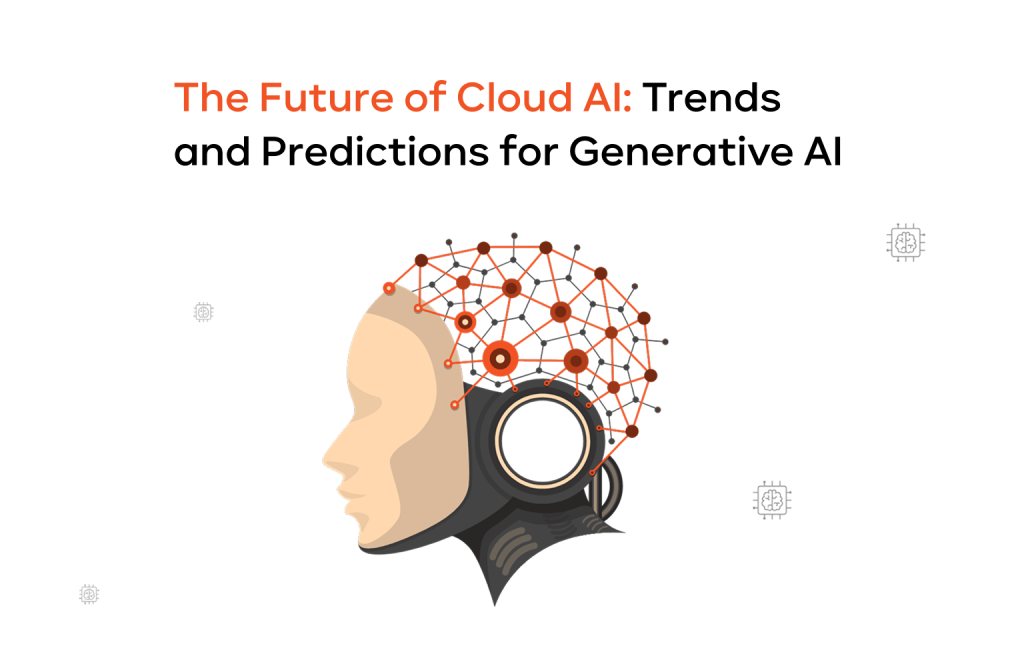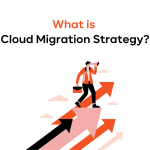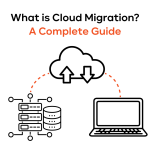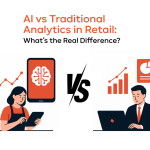Cloud computing and generative AI trends are changing how many industries work. AI can now create new text, images, music, and more. This shift is huge. It allows businesses to unlock new ways to cut costs, design better products, and serve customer needs. None of this would be possible at scale without cloud infrastructure. The cloud offers flexible compute resources and user-friendly platforms. As a result, even organizations with small budgets can join this AI revolution.
In the sections below, we will explore how different fields benefit from generative AI and which changes to expect in the future. You will learn how cloud services enable faster AI development. You will also read why many experts see a bright future in AI-driven solutions, and how your business might tap into these practices.
Overview of generative AI and its impact on various industries
Generative AI refers to AI models that do more than analyze data. They create new and useful content. This content may be text, images, music, or other forms of media. These models learn how to produce content by studying patterns in existing datasets. Then they generate results that follow those patterns.
A simple example is a text generation tool trained on a trove of news articles. It learns common language structures, grammar rules, and topic details. Later, when given a prompt, it can draft a coherent story. This method also applies to art, where an AI might paint an image in the style of famous artists.
Many see this as a turning point in technology. AI can now “create” rather than just respond. This has opened new potential across many fields.
Use of generative AI trends has grown in retail, e-commerce, healthcare, entertainment, manufacturing, and more. For instance:
- Retail: Generative AI is used to boost employee productivity. For example, it automates tasks like document analysis. In retail stores, it can be used for virtual try-ons. In addition, AI helps with supply and inventory management by forecasting demand, etc.
- E-commerce: AI is widely adopted to improve customer interactions and operations. This refers to customer support, product recommendations, content creation, sentiment analysis, etc. This drives efficiency and growth of e-commerce businesses.
- Healthcare: AI-driven analytics help discover new drugs. By examining large chemical databases, AI can propose fresh compound structures. This saves time and money. It also allows quick testing of possible treatments, easing the path toward drug approval.
- Entertainment: AI-powered systems can craft movie scripts, fine-tune game scenarios, or generate background music. This cuts down on manual creation time. It also opens new avenues for creativity. Teams can iterate faster and produce content that feels unique.
- Manufacturing: Designers are using AI-based applications to create product prototypes. These tools propose efficient shapes or materials. They weigh function and cost, helping teams refine products with fewer resources. This can also speed up operations and reduce production waste.
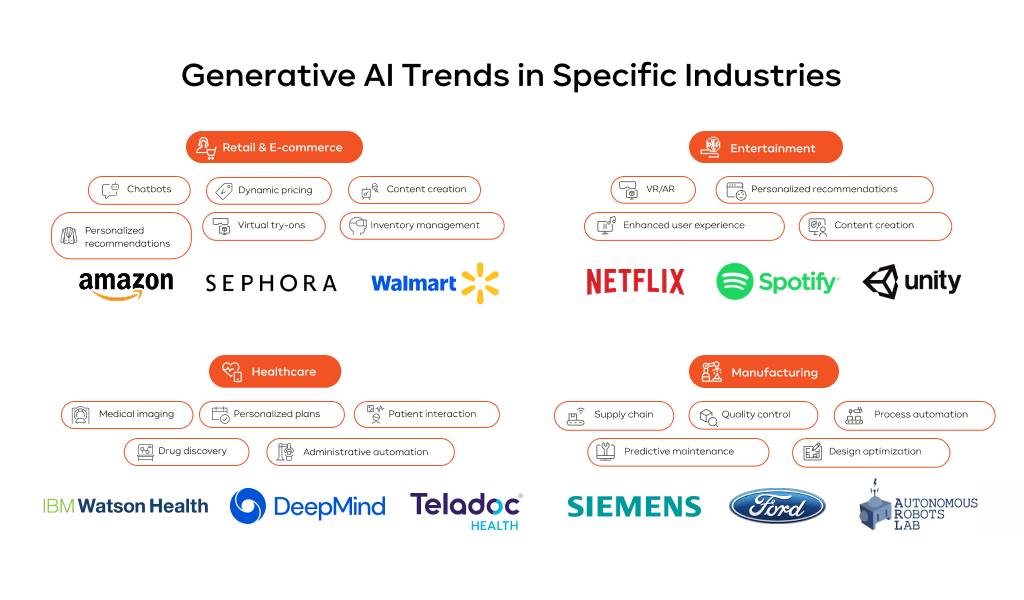
When used wisely, the generative AI latest trends can give real benefits. They help companies pivot, cut costs, and spark innovation. However, teams must also address data quality and security. They must integrate AI with existing systems and ensure each process meets strict quality controls.
The role of cloud computing in advancing AI capabilities
Cloud computing is a prime driver behind trends in generative AI. Many organizations tap into shared infrastructure rather than building their own data centers. They rent compute time and storage from a cloud provider, which frees them to focus on refining their AI algorithms.
This approach reduces up-front costs. It also makes advanced AI tools and resources available to those who couldn’t afford on-premise gear. Large and small teams alike benefit from constant hardware upgrades, managed by the cloud vendor.
Projects that use AI can fluctuate in size and computing needs. Cloud platforms are perfect for this. A team can start small, paying only for what they use. Then, if their AI model becomes successful, they can ramp up. This elasticity means no extra money is spent on unused hardware.
Scalability is key for big data tasks. Think of a generative art model that needs to train on thousands of images each day. Running it on physical machines might take weeks or months to set up. In the cloud, teams can add more GPU or TPU nodes on demand, speeding time to market.
Evolution of generative AI in the cloud
Generative AI has come a long way thanks to better neural network designs and more specialized hardware. The cloud has kept pace, offering robust tools that reduce friction for AI developers. Let’s dive into some of these advancements that encourage generative AI trends.
How cloud infrastructure supports generative AI development
Most cloud services provide built-in frameworks and libraries. Developers use these to build, train, and deploy AI models. Examples include TensorFlow, PyTorch, or AWS SageMaker:
- GPU/TPU access: Many deep learning tasks need strong processing power. Cloud vendors let you pick high-performance hardware right away.
- Managed environments: You don’t have to manage servers. Instead, you click a few buttons, and your training environment is ready to go.
- Automation: Cloud pipelines handle tasks like data cleaning, model testing, and versioning. This makes the AI workflow more consistent.
Advancements in AI models with cloud-based training and inference
The cloud encourages ongoing experimentation. You can train a model, test it, see results, then revise and retrain fast. This loop helps keep models fresh and relevant:
- Scheduled retraining: When new data arrives, the system can trigger automated retraining. This keeps the AI from becoming outdated.
- Dynamic deployment: Once the model is ready, it moves to production with a few clicks. Cloud load balancers then distribute the workload worldwide for speed and reliability.
The shift from on-premise AI to cloud-native AI solutions
On-premise AI requires big budgets for servers, cooling, and specialized staff. Cloud-native AI changes this model:
- Lower maintenance: The cloud provider handles patching, repairs, and security updates.
- Easier collaboration: Remote teams can work in the same environment at the same time.
- Agile development: It’s simpler to start a proof of concept or move it to production. No physical servers need to be ordered, racked, or replaced.
_______________________________________________________________________
Want to start building cloud-based AI solutions?
Take advantage of flexible, cost-effective resources that drive results. Learn how we can help shape your business strategy with advanced AI.
_______________________________________________________________________
Key trends shaping the future of cloud AI
Many generative AI market trends promise to change the way teams build and use AI. Read on for an overview of the most important shifts.
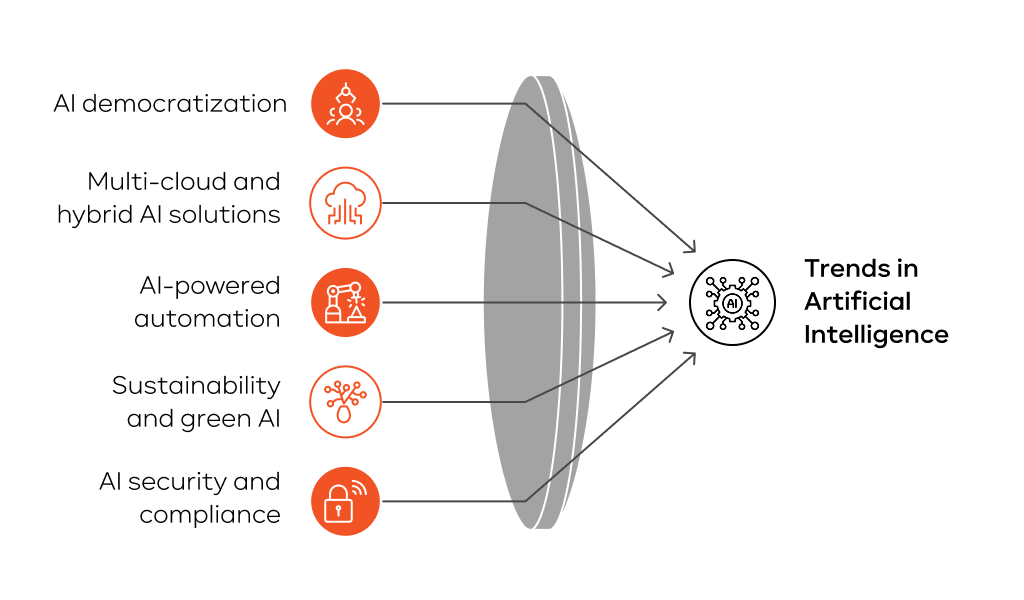
AI democratization – increased accessibility through cloud platforms
Generative AI trends push to make AI more accessible. Low-code and no-code solutions let non-experts build AI-based applications. This benefits many small and medium businesses or niche use cases where hiring AI talent might be too expensive.
- User-friendly tools: Graphical interfaces help users deploy models without writing much code.
- Community support: Tutorials and examples spread knowledge. People in education, agriculture, or local services can benefit from technology they once saw as too complex.
Multi-cloud and hybrid AI solutions – balancing performance, cost, and compliance
Some companies prefer a multi-cloud plan. They use different providers for different tasks. This reduces lock-in and can improve cost control:
- Performance mix: Host compute-intensive tasks on one cloud and standard tasks on another.
- Regulatory needs: A hybrid system can keep sensitive data in local servers. It also uses public cloud for less risky workloads.
- Resilience: If one cloud goes down, the other can keep essential operations running.
AI-powered automation – enhancing workflows and decision-making
As the latest trends in generative AI grow, AI is not just about novelty. It’s a practical tool to automate daily work:
- Repetitive tasks: AI can scan documents, fill forms, or respond to routine emails. This reduces human error.
- Smart insights: AI reviews large datasets and surfaces outliers or trends. Managers act faster with better information.
- Seamless integration: With APIs, these AI capabilities plug into existing systems. That means less friction during rollout.
Sustainability and green AI – reducing carbon footprint with optimized AI models
Training large AI models can use lots of energy. This has led to the rise of green AI. Such sustainable generative AI trends touch upon:
- Model compression: Pruning parts of a model can slash computing needs.
- Efficient data centers: Cloud provider data centers are moving toward renewable energy and better cooling systems.
- Frequency of training: Teams can adjust how often they retrain a model. More frequent training must be balanced against energy use.
AI security and compliance – addressing privacy, bias, and ethical concerns
Companies that adopt AI at scale need to tackle privacy, bias, and compliance. Due to its acute relevance, this topic is now one of the most important generative AI trends.
- Data protection: For user data, encryption and secure storage are vital.
- Bias checks: Some algorithms may reflect historical bias in their outputs. Tools now exist to detect and address this.
- Legal standards: Governments are drafting rules around AI transparency. Firms must keep up with these evolving requirements.
Impact of emerging technologies
Generative AI doesn’t stand alone. It combines with other new ideas, including edge computing, quantum computing, and data privacy efforts.
Role of edge computing in AI performance
Edge computing influences generative AI trends. It brings processing closer to where data originates. That could be a sensor in a factory or a smartphone in someone’s hand:
- Faster response: Data doesn’t have to travel to a distant center. This improves speed in tasks like object recognition for robots.
- Lower cloud costs: Only key insights are sent to the cloud, saving bandwidth.
- Offline capabilities: If the internet goes down, local edge devices can still handle some operations.
Influence of quantum computing on AI algorithms
Though still in development, quantum computing could offer a leap in processing power. It uses qubits, which hold multiple states at once:
- Faster problem solving: Complex tasks like protein folding or complex optimization might be solved in minutes instead of years.
- Novel AI methods: Combining quantum hardware with classical AI might open new ways to refine models.
- Research boom: Tech leaders invest in quantum labs, hoping to find advantages for analytics and big data tasks.
Importance of data privacy and ethical considerations
With new AI tools, data privacy is crucial. When an AI learns from user information, it must follow proper practices:
- Differential privacy: Adds controlled “noise” so real user data isn’t revealed.
- Federated learning: AI trains on local devices. Then it merges learnings without collecting raw data.
- Policy boards: Companies often form ethics teams to evaluate if AI usage harms or exploits certain groups.
Building trust is essential. This trust can help firms stay competitive and avoid legal issues. That is why it is among generative AI trends now.
Predictions for generative AI in the cloud
Looking ahead, generative AI industry trends will continue to expand. The cloud is central to that growth. Below, we explore how these changes may shape the AI market in the coming years.
Growth in AI-as-a-Service (AIaaS) offerings
Some cloud vendors now sell AI as a subscription, known as AIaaS. Users pay monthly or yearly fees. In return, they gain access to ready-made AI features. These range from text or speech algorithms to image recognition.
The perspectives are:
- Lower barriers: Any business can tap into AI without big setup costs.
- Scalability: As usage grows, companies can upgrade their plan and resources.
- Market boom: Gartner’s 2023 AI Market Forecast predicts strong growth in the AIaaS sector.
For a deeper look, see our article: “AI as a Service (AIaaS): Benefits, Providers, and Best Practices”.
Advances in personalized AI models and synthetic media
Many see personalization as the next big move in generative AI trends. Instead of generic outputs, models will tailor results for individual users:
- Targeted marketing: Ad content and offers can be shaped by each person’s viewing habits.
- Adaptive education: Interactive lessons respond to each student’s progress or trouble spots.
- Synthetic media: AI can create life-like avatars for language translation or custom virtual hosts.
Integration of AI with IoT and edge computing
IoT devices gather data from the physical world. AI can transform this data into insights, especially with advanced integration:
- Factory maintenance: Sensors watch for unusual vibrations. AI flags problems before a breakdown.
- Smart homes: Thermostats, locks, and lights learn user habits. They adjust settings automatically.
- Connected cities: Traffic lights adapt to real-time flow. Public services become more efficient.
More robust AI regulations and governance frameworks
Governments are crafting new policies around AI use. Businesses can prepare by building strong governance:
- Ethical guidelines: Make sure AI outputs don’t discriminate or mislead.
- Compliance tools: Track how data is processed to show legal adherence.
- International collaboration: As AI grows, nations may coordinate on shared rules, ensuring fair global operations.
Conclusion
In summary, generative AI trends present a major leap forward in how we use AI. The cloud stands at the center of this change. It provides the resources, frameworks, and platforms to train and deploy large AI models. This leads to faster innovation cycles and lower costs.
Many industries benefit from e-commerce and healthcare to marketing and manufacturing. But there are challenges too. Companies must safeguard data privacy, meet compliance rules, and make sure they use AI in a fair way. As the field grows, we’ll see new breakthroughs in edge computing, quantum computing, and even more advanced AI services.
By staying proactive, organizations can shape the future rather than just react to it. This is a prime chance for leaders to get ahead, offer new solutions, and build business value that stands the test of time.
Ready to bring the generative AI trends to your projects?
Receive help with planning, deploying, and managing AI-driven solutions that deliver real value for your business. Let’s discuss your custom roadmap!
FAQ
What are the advantages of cloud solutions over on-premise AI systems?
Cloud solutions provide scalability, lower costs, and easier updates. You can add or remove resources as needed. This helps manage peak loads or cut back when usage is low. The cloud provider also handles maintenance and security patches, saving your team time.
How do cloud platforms make AI more accessible?
They bundle tools and services for data handling, model building, and deployment. You don’t need a large IT staff to set up infrastructure. Pay-as-you-go pricing also opens doors for startups or smaller firms to test AI ideas.
How will AI integrate with IoT and edge computing?
AI will run on edge devices that gather and process data in real time. By analyzing data on the spot, these systems reduce latency and save bandwidth. This is useful for factories, smart homes, and connected cities. They rely on faster processes that respond to events before sending only necessary details back to the cloud.
